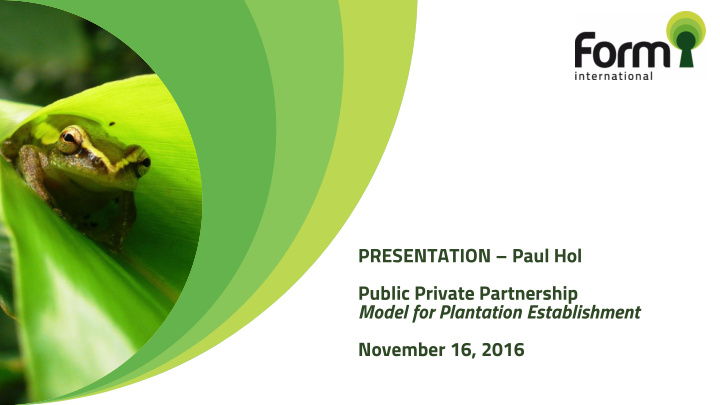



PRESENTATION – Paul Hol Public Private Partnership Model for Plantation Establishment November 16, 2016
INTERNATIONAL CONFERENCE ACCRA, GHANA Forests for the future - New Forests for Africa Main conclusions • Access to finance • Transfer of knowledge & training • Awareness on sustainability aspects of forest plantations
PAUL HOL CEO Sustainable Forestry Investments
GENERAL OBJECTIVES • investment in large scale agro and timber plantations primarily based in Africa • sound returns on investment (10-12%) in combination with value creation • management in a sustainable way preferably through afforestation of degraded land • certified according to the 10 Principles of FSC
Management & TA Organisation FSC, VCS, silvicultural, social, Permanent organisation ecological, financial 2,200 persons Infrastructure
SPECIFIC OBJECTIVES 2016 - 2020 Ghana • current 7,500 ha to 12,000 ha in 2020 • additional investment in 10,000 ha Tanzania • Current 2,700 ha sisal to 3,500 ha in 2020 • Establish 3,000 ha forest plantations (2,200 ha EUC, 600 ha Teak) • additional investment in 10,000 ha Total 38,500 ha
AN ENABLING ENVIRONMENT “ You always need to have an enabling environment. And the right regulatory system to encourage investors to invest, whether they are domestic or international. Any attempt to revive forest, to replant and go through reforestation in a broad sense, is something that helps not only Ghana, but also helps the global fight against climate change .” Kofi Annan, Accra March 2016
GHANA 1980: 8.2 M Ha 2010: 1.2 M Ha AAC: 1 M Production capacity: 2 – 3 M
Form Ghana Plantation Areas
ASUBIMA FOREST RESERVE 1973
ASUBIMA FOREST RESERVE 1986
ASUBIMA FOREST RESERVE 2003
FORM GHANA LTD. Reforestation of degraded forest areas Forests for the Future!
LAND LEASE AGREEMENT ON DEGRADED FOREST RESERVES • Traditional land owners • Forestry Commission • Form Ghana as investor
LAND LEASE AGREEMENT IS ACCOMPANIED BY A BENEFIT SHARING AGREEMENT • Initial payment to traditional land owners • Annual land rent • Revenu shares for traditional land owners / communities and Forestry Commission This agreement is acceptable to all parties: New model for Ghana
PUBLIC PRIVATE PARTNERSHIP A joint effort between Forestry Commission, traditional land owners and investor
PUBLIC PRIVATE PARTNERSHIP Why? To get clear and sound collaboration on the land use, land rights and tasks of the three stakeholders, Forestry Commission, traditional land owners and investor
PUBLIC PRIVATE PARTNERSHIP Roles and responsibilities Forestry Commission • Facilitate interaction stakeholders • Survey, demarcation and mapping • Official registrations • Assistance with fire management • Community education • Provision of field coordinator • Monitoring and reporting
PUBLIC PRIVATE PARTNERSHIP Roles and responsibilities Traditional land owners • Involved in stakeholder meetings • Active partnership on fire fighting to mitigate land degradation on forest land and agricultural land • Benefits from land rent and revenu share = key for long-term commitment! • Employment, economic development
PUBLIC PRIVATE PARTNERSHIP Roles and responsibilities Investor • Financial resources • Plantation establishment and management • Management according to strict rules of Forestry Commission • Collaboration with local authorities on law enforcement (illegal logging, burning, hunting, watershed management etc.)
PUBLIC PRIVATE PARTNERSHIP on reforestation has greatly improved the relationship between parties and implementation: • More frequent contact with Forestry Commission • Assistance with legal issues • Assistance with combatting illegal activities • Help with importing improved planting material PPP has become the new standard!
PUBLIC PRIVATE PARTNERSHIP An enabling environment to provide incentives for long-term investors = An opportunity for Tanzania!
Opportunities for optimal landuse in Tanzania
THANK YOU FOR YOUR ATTENTION! Conference website: www.newforestsforafrica.org
Recommend
More recommend